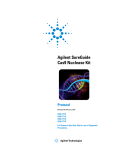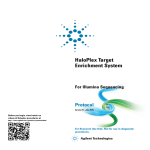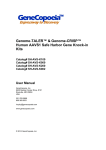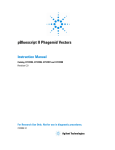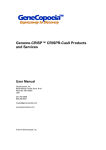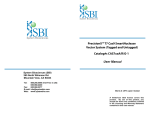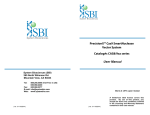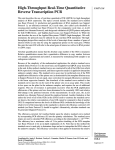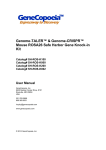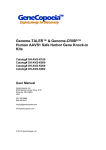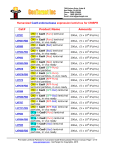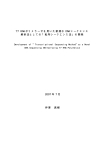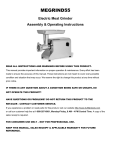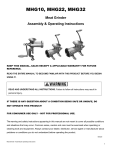Download Agilent SureGuide gRNA Synthesis Kit Guide
Transcript
Agilent SureGuide gRNA Synthesis Kit Protocol Revision B0, February 2015 5190-7714 5190-7719 For Research Use Only. Not for use in Diagnostic Procedures. Agilent Technologies Notices © Agilent Technologies, Inc. 2015 Warranty No part of this manual may be reproduced in any form or by any means (including electronic storage and retrieval or translation into a foreign language) without prior agreement and written consent from Agilent Technologies, Inc. as governed by United States and international copyright laws. The material contained in this document is provided “as is,” and is subject to being changed, without notice, in future editions. Further, to the maximum extent permitted by applicable law, Agilent disclaims all warranties, either express or implied, with regard to this manual and any information contained herein, including but not limited to the implied warranties of merchantability and fitness for a particular purpose. Agilent shall not be liable for errors or for incidental or consequential damages in connection with the furnishing, use, or performance of this document or of any information contained herein. Should Agilent and the user have a separate written agreement with warranty terms covering the material in this document that conflict with these terms, the warranty terms in the separate agreement shall control. Manual Part Number 5990-7261 Edition Revision B0, February 2015 Agilent Technologies, Inc. 5301 Stevens Creek Blvd Santa Clara, CA 95051 For Research Use Only. Not for use in Diagnostic Procedures. Technology Licenses The hardware and/or software described in this document are furnished under a license and may be used or copied only in accordance with the terms of such license. Restricted Rights Legend If software is for use in the performance of a U.S. Government prime contract or subcontract, Software is delivered and licensed as “Commercial computer software” as defined in DFAR 252.227-7014 (June 1995), or as a “commercial item” as defined in FAR 2.101(a) or as “Restricted computer software” as defined in FAR 52.227-19 (June 1987) or any equivalent agency regulation or contract clause. Use, duplication or disclosure of Software is subject to Agilent Technologies’ standard commercial license terms, and non-DOD Departments and Agencies of the U.S. Government will receive no greater than Restricted Rights as defined in FAR 52.227-19(c)(1-2) (June 1987). U.S. Government users will receive no greater than Limited Rights as defined in FAR 52.227-14 (June 1987) or DFAR 252.227-7015 (b)(2) (November 1995), as applicable in any technical data. Safety Notices CAUTION A CAUTION notice denotes a hazard. It calls attention to an operating procedure, practice, or the like that, if not correctly performed or adhered to, could result in damage to the product or loss of important data. Do not proceed beyond a CAUTION notice until the indicated conditions are fully understood and met. WA R N I N G A WARNING notice denotes a hazard. It calls attention to an operating procedure, practice, or the like that, if not correctly performed or adhered to, could result in personal injury or death. Do not proceed beyond a WARNING notice until the indicated conditions are fully understood and met. Agilent SureGuide gRNA Synthesis Kit Protocol Agilent SureGuide gRNA Synthesis Kit Kit Components and Storage Conditions 4 Required and Optional Equipment and Reagents 5 Introduction to gRNA Synthesis 6 Preprotocol Considerations 7 CRISPR and tracr sequences 7 DNA template requirements and design 8 T7 RNA polymerase promoter primer 9 Template input 10 Procedures 12 Transcribe the gRNA from the DNA template 12 Purify the gRNA 13 gRNA Analysis 15 Spectrophotometric analysis 15 Electrophoretic analysis 15 Supplementary Protocols 17 Fill-in procedure for “Template option B” 17 Purification of double stranded template 18 Supplementary Design Information 19 gRNA and DNA template sequences for an example DNA target 19 References 23 Agilent Technologies 3 Kit Components and Storage Conditions Component SureGuide CRISPR/Cas Complete Kit, p/n 5190-7714 SureGuide gRNA Synthesis Kit, p/n 5190-7719 Storage temperature Cas9 Nuclease 40 µL — –20°C 10X Cas9 Digestion Buffer 2 × 40 µL — –20°C RNase Free Water 2 × 1.5 mL — –20°C Control DNA Target, 50 ng/μL 2 × 20 µL — –20°C Control gRNA, 1μM 2 × 10 µL — –20°C T7 Promoter Forward Primer 25 µL 25 µL –20°C Control Template 50 µL 50 µL –20°C DTT 50 µL 50 µL –20°C RNase Free DNase 50 µL 50 µL –20°C T7 RNA Polymerase 50 µL 50 µL –20°C 100 mM rATP 50 µL 50 µL –20°C 100 mM rGTP 50 µL 50 µL –20°C 100 mM rUTP 50 µL 50 µL –20°C 100 mM rCTP 50 µL 50 µL –20°C 5X RNAMaxx Transcription Buffer 250 µL 250 µL –20°C Yeast Pyrophosphatase 25 µL 25 µL –20°C RNase Block 50 µL 50 µL –20°C DEPC treated water 1 mL 1 mL –20°C gRNA Binding Buffer 5 mL 5 mL Room temperature 5X gRNA Wash Buffer 7 mL 7 mL Room temperature gRNA Elution Buffer 2.5 mL 2.5 mL Room temperature RNA Binding Spin Cups and 2-mL Receiver Tubes 50 each 50 each Room temperature Tubes, 1.5-mL 50 each 50 each Room temperature 4 490 Micro GC User Manual Required and Optional Equipment and Reagents Table 1 Required and optional equipment and reagents for the gRNA synthesis protocol Equipment or Reagent Molecular biology grade ethanol Microcentrifuge RNA quantitation method (UV spectrophotometer or dye-based RNA quantitation method) (Optional) BioAnalyzer Small RNA Kit, Agilent p/n 5067-1548 Incubator, heat block, or temperature cycler for 37°C incubations RNase-free reaction tubes User-defined DNA template, 0.1–1 μM 490 Micro GC User Manual 5 Introduction to gRNA Synthesis Cas9 (CRISPR associated protein 9) is an RNA- guided DNA nuclease associated with Type II bacterial CRISPR immunity systems. Cas9 is widely used to induce site- specific double- stranded breaks in DNA for multiple applications. The guide RNA (gRNA) structure that binds and directs Cas9 is a hybrid of CRISPR RNA, containing homologous sequence to the cleavage target, and a trans- activating tracrRNA. A single guide RNA chimera of the CRISPR and tracrRNAs can direct DNA cleavage by Cas9 in- vitro in lieu of the naturally occurring duplex1. The SureGuide gRNA Synthesis kit is intended for the preparation of guide RNAs to be used in conjunction with recombinant Cas9 enzyme for the in vitro site specific cleavage of double stranded DNA. The RNA guides are synthesized by T7 RNA polymerase transcription from a DNA template of your choice. Figure 1 6 Depiction of gRNA directed Cas9 cleavage of double stranded DNA 490 Micro GC User Manual Preprotocol Considerations NOTE SureDesign, Agilent’s online web tool, offers an easy-to-use wizard that allows you to design gRNA sequences for a defined DNA target. The DNA target can be from an uploaded BAC, plasmid, or other sequence, as well as from user selected regions in the human genome and common model organisms. The wizard takes you through the steps of defining the target regions and setting parameters for the gRNA sequences. The SureDesign algorithm then lists gRNA sequences and ranks them in order of target specificity. The end-result is a set of files that includes the sequences and positions of the gRNAs, the secondary hits for each gRNA, the corresponding single guide RNA (sgRNA) sequences, and the sequences of the DNA template to be used to synthesize the dual gRNAs or sgRNAs if using in vitro transcription. To set up a SureDesign account, visit the SureDesign website at www.agilent.com/genomics/suredesign. CRISPR and tracr sequences The Control DNA Template that is provided in the SureGuide gRNA Synthesis Kit encodes a sgRNA with a minimal length CRISPR/tracr backbone (see the “minimal design” sgRNA in Figure 1). This minimal backbone sequence is adequate for many cleavage targets. However, for many targets, we have observed improved cleavage using the extended, native CRISPR/tracr backbone sequence (see the “extended design” gRNAs in Figure 1). You may wish to design your gRNAs to encode minimal or extended backbones depending on your specific needs. Because we have never observed a decrease in cleavage efficiency using an extended backbone, we recommend designing gRNAs with this backbone unless there is a compelling reason to use the minimal backbone instead. Example sequences of gRNAs with both minimal and extended backbones are provided in the section “Supplementary Design Information” on page 19. All DNA templates used with the SureGuide gRNA Synthesis Kit must incorporate the T7 RNA polymerase promoter followed by GG. The GG nucleotides are ideally encoded at the 5’ end of the 20 nucleotide user- defined target sequence, but may be incorporated as bases unmatched to the DNA target. The GG nucleotides in the Control gRNA provided in the kit do not match the Control DNA Target, and we have not observed a difference in cleavage efficiency with and without the extraneous GGs. The user- defined 20 nucleotide target sequence must be immediately upstream of an 490 Micro GC User Manual 7 Streptococcus pyogenes protospacer adjacent motif (PAM) site, which has the sequence NGG. DNA template requirements and design In order to synthesize gRNA using the SureGuide reagents, you must have DNA templates which include a T7 RNA polymerase promoter to synthesize your desired gRNA. In the depiction of Cas9 cleaving a double- stranded DNA target shown in Figure 1, the fixed sequence of the mature guide (green and blue text) is universal for use with Cas9 from S. pyogenes, but the 5’ end of the molecule (red text) has 20 bases of sequence unique to the cleavage target. Cleavage targets must be 20 bases in length and located immediately upstream of an S. pyogenes PAM site. Cas9 cleavage occurs 3 bp upstream (5’) of the PAM site. Any DNA template containing a T7 RNA polymerase promoter can be used, but we recommend using oligonucleotides or synthetic gene fragments as templates since they do not require any cloning steps, are more cost effective, and are widely available. Multiple iterations of DNA templates have been used successfully and are selected based on user preference, length of the guide, cost, turnaround time, and ease of use. In general, there are three basic options for DNA template design, which are illustrated in Figure 2. Template option A Uses a long, single- stranded oligonucleotide template. This is the design used for the Control Template included in the SureGuide kit. Template option B Option B uses two partially overlapping oligonucleotides. This design approach requires DNA polymerase extension to fill in the template prior to gRNA synthesis. See “Fill- in procedure for “Template option B”” on page 17. Template option C Option C uses a synthetic double- stranded gene fragment as the DNA template. Gene fragments are available from multiple vendors. These vendors often have minimum length requirements for gene fragments, which your template might fail to meet. In order to meet a minimum length requirement, the gene fragment sequence can be designed with nonspecific filler or stuffer sequence upstream of the T7 promoter. 8 490 Micro GC User Manual Figure 2 DNA Template options. A) Long, single-stranded oligonucleotide template. B) Two partially overlapping oligonucleotides; requires fill-in with DNA polymerase. C) Synthetic double stranded gene fragments; may require 5’ stuffer sequence to meet length requirement. T7 RNA polymerase promoter primer Shown below is the sequence of the T7 Promoter Primer to be used with single stranded oligonucleotide templates (“Template option A”). The T7 Promoter Primer is provided with the kit at a 10 µM concentration. 5' CGATGTAATACGACTCACTATAGG 3' • The underlined sequence is the minimal T7 promoter required in all DNA templates for transcription. • The +1 base (in bold italic) is the first base incorporated into the transcript. The two G’s following the promoter are required for efficient transcription. Removal of these nucleotides from the sequence will result in a significantly reduced yield of gRNA. The addition of two nonpairing Gs at the 5’ end of a guide may or may not affect the specificity or alter the cleavage efficiency of Cas9 digestion of your target. If this is of concern, guide sequences can be selected from the target sequence that encode ‘GG’ at the 5’ end. If your gRNA does not start with 2 consecutive Gs, we recommend adding them to the 5’ end of the gRNA. 490 Micro GC User Manual 9 Template input The amount of DNA template added to the gRNA synthesis reaction greatly influences the total yield, as illustrated in Figure 3. We recommend a concentration of 200 nM to generate the highest possible yield within a one hour incubation time. There may be limitations on the amount of template available based on the source and type of template being used. Low concentration templates can be PCR- amplified to produce additional material, if desired, however this is not required as the gRNA synthesis can be performed with as little as 20 nM template in the reaction. You can also increase the yield by simply lengthening the incubation time (see Figure 4). Figure 3 10 The effect of template input on yield of gRNA. gRNA was synthesized from two different gene fragment templates at five different input concentrations (12.5 nM, 25 nM, 50 nM, 100 nM, and 200 nM). The standard procedure was used with a 1 hour incubation. The gRNA yield in µM is shown plotted against the concentration of DNA template in the transcription reaction. At the lowest template concentration tested (12.5 nM), the yields were 8.4 µM and 7.6 µM for the two test templates, enough for >380 in-vitro Cas9 control digests. 490 Micro GC User Manual Figure 4 490 Micro GC User Manual The effect of increased incubation time on yield of gRNA. gRNA was synthesized from three different gene fragment templates using a template concentration of ~20 nM/reaction. Three identical reactions per target were set-up and incubated for 1, 2, or 20 hours at 37 °C. The gRNA yield in ng/µL is shown plotted against the incubation time of the transcription reaction. Although the absolute yield for the different templates varied, improved yield with increased incubation time was observed for all three. 11 Procedures Use universal precautions for working with RNA throughout the procedures. Transcribe the gRNA from the DNA template 1 Thaw the kit components that are stored at –20°C. For the T7 polymerase, RNase Block, DNase, and Yeast Pyrophosphatase, thaw on ice. Thaw the 5X Transcription Buffer, rNTPs, DTT, and T7 Promoter Primer (if using) at room temperature. Once thawed, mix well by vortexing, briefly spin to pellet any droplets, and transfer to ice. 2 On ice, prepare enough master mix for at least 1–2 additional reactions over the required amount. Table 1 shows the volumes of each component required for one reaction. Use the left column for single stranded oligo templates requiring the T7 forward Promoter Primer. Use the right column for double stranded DNA templates. Table 2 NOTE 12 Master mix component volumes per reaction Component Volumes for reactions with single-stranded templates or the Control Template Volumes for reactions with double-stranded templates DEPC Water 7 µL 7.5 µL 5X Transcription Buffer 5 µL 5 µL rATP 1 µL 1 µL rCTP 1 µL 1 µL rGTP 1 µL 1 µL rUTP 1 µL 1 µL 0.75M DTT 1 µL 1 µL Yeast Pyrophosphatase 0.5 µL 0.5 µL RNase Block 1 µL 1 µL T7 RNA Polymerase 1 µL 1 µL 10 µM T7 Promoter Primer 0.5 µL — Total 20 µL 20 µL For convenience, you can combine the stocks of rATP, rCTP, rGTP, and rUTP and store them as a mixture. You would then add 4 μL of the mixture per reaction to the master mix in Table 2 instead of adding 1 μL of each rNTP individually. 490 Micro GC User Manual 3 Aliquot 20 µL of master mix to the appropriate number of RNase- free reaction tubes. From this point, the reaction set- up can be completed at room temperature. 4 Add 5 µL of template DNA (or 5 µL of 1 µM Control Template) to each reaction. Cap the tubes securely. For maximum yield in one hour, we recommend a final DNA template concentration of 200 nM in the reactions, which corresponds to a stock concentration of 1 µM. Stock concentrations as low as 0.1 µM template can be used, however, we then recommended increasing the incubation time of the reaction. 5 Mix samples by vortexing then spin briefly to eliminate droplets and bubbles. 6 Transfer the reactions to a 37°C incubator or heat block. 7 Incubate the reactions for at least 1 hour, but no longer than overnight (16–20 hours), to transcribe the gRNA. 8 Following the incubation, add 1 µL of RNase- free DNase to each transcription reaction. 9 Mix well and incubate for another 15–20 minutes at 37°C. Following the DNase digestion, the gRNA samples are ready to be purified. You may proceed directly to the purification, or freeze the samples at –80°C until ready to proceed. Purify the gRNA Before starting 490 Micro GC User Manual 1 Prepare the gRNA Binding Solution by adding 7.5 mL of molecular biology grade ethanol directly to the bottle (final ethanol concentration = 60%). Mix well and store at room temperature. 2 Prepare the gRNA Wash Buffer by adding 28 mL of molecular biology grade ethanol directly to the bottle (final ethanol concentration = 80%). Mix well and store at room temperature. 13 Purification procedure 1 If frozen, bring the unpurified gRNA samples to room temperature. 2 Prepare a spin cup filter for each sample to be purified by seating a spin cup filter in a fresh 2 mL receptacle tube. Label the tubes appropriately. 3 Label a 1.5- mL tube for each sample and set aside. These tubes will be used as the receptacles for the final elution. 4 Add 200 µL of gRNA Binding Solution (confirm ethanol has been added) to each sample. Mix gently by pipetting up and down a few times. 5 Transfer the entire volume of each sample (226 µL) to an individual spin filter cup. 6 Spin the filter cups at maximum speed in a microcentrifuge for 1 minute. 7 Remove the spin cup and discard the eluate. Replace the spin cup back into the receptacle tube. 8 Wash the filter by adding 600 µL of gRNA Wash Buffer (confirm ethanol has been added) to each spin filter cup. 9 Spin the filter cups at maximum speed in a microcentrifuge for 1 minute. 10 Remove the spin cup and discard the eluate. Replace the spin cup back into the receptacle tube. 11 Spin the filter cups for 2 minutes at maximum speed to dry the filter matrix. 12 Transfer the dry spin cup to its respective pre- labeled 1.5- mL tube for final elution. 13 Using a clean pipette tip for each sample, carefully pipette 50 µL of gRNA Elution Buffer directly to the center of the filter matrix inside each spin cup. 14 Spin the filter cups at maximum speed in a microcentrifuge for 1 minute. 15 The eluate is the purified gRNA sample. Discard the spin cup and cap the tube. 16 Determine the gRNA concentration using a preferred method. You may also want to calculate the µM concentration for use in subsequent applications. 17 Store gRNA stocks at –80°C. 14 490 Micro GC User Manual gRNA Analysis The ultimate confirmation of the quality of any gRNA is demonstrating performance in a digest with Cas9 and confirming cleavage at the desired location. However, this analysis could give a negative result or unsatisfactory digestion for reasons other than the quality of the gRNA. It may be necessary to analyze gRNA samples to eliminate them as a source of negative results. Spectrophotometric analysis If your Cas9 nuclease reactions yield completely negative results, we recommend that you first double check the design/sequence of the DNA template. The second line of analysis is to perform standard nucleic acid spectrophotometric readings on the gRNA samples at A230, A260, and A280. If the A260/A280 ratio (1.8–2.1 expected) or the A260/A230 ratio (~2.0 expected) is not as expected, this can indicate that samples may have inhibitory levels of protein or chemical contamination. A significantly lower RNA concentration, compared to an earlier determination of RNA concentration, could indicate RNase contamination. Electrophoretic analysis In addition to spectrophotometric analysis, analyzing the gRNAs by electrophoresis is another way to check sample quality. Any electrophoresis method that will resolve very small RNA molecules (40–120 nucleotides) will give satisfactory results, however we recommend using the Agilent BioAnalyzer Small RNA Chip. A good result (see Figure 5) is a clean band of approximately the correct size with no evidence of degradation (e.g. smearing or banding at lower molecular weight). To eliminate secondary structure, heat the sample to 80°C for 2 minutes prior to analysis. 490 Micro GC User Manual 15 Figure 5 16 BioAnalyzer Small RNA Chip Analysis of gRNA. 1 µM dilutions of two different gRNAs were prepared in TE Buffer, pH 7.0, and heated to 80°C for 2 minutes then cooled on ice. 1 µL was analyzed on an Agilent BioAnalyzer Small RNA Chip according to the manufacturer’s instructions. The 64 nt gRNA in lane 1 is the Control gRNA included with the kit, which is synthesized using a long single-stranded oligonucleotide template (“Template option A”). The 108 nt gRNA in lane 2 was synthesized using a gene fragment template (“Template option C”). 490 Micro GC User Manual Supplementary Protocols Fill-in procedure for “Template option B” If you are using “Template option B”, you will need to fill in the template prior to gRNA synthesis. Due to the strong secondary structure of Cas9 gRNAs, fill- in reactions should be performed with a thermophilic DNA polymerase. The protocol below is based on Agilent’s Herculase II Fusion DNA Polymerase (p/n 600675). In preparation for the fill- in reaction, resuspend primers at a final concentration of 10 µM. 1 In a tube suitable for a thermocycler, assemble the mixture in Table 3. Table 3 490 Micro GC User Manual Fill-in reaction volumes Component Volume per reaction 5X Herculase II Reaction Buffer 10 µL dNTPs (10 mM each) 1 µL Forward primer (10 µM) 5 µL Reverse primer (10 µM) 5 µL Herculase II Fusion DNA Polymerase 1 µL dH2O 28 µL Total 50 µL 2 In a thermocycler, incubate for 2 minutes at 95°C, followed by 1 minute at 60°C, and then 3 minutes at 72°C. 3 You can now purify the filled- in DNA template using the procedure described below in “Purification of double stranded template” on page 18. 17 Purification of double stranded template Products from the above fill- in reaction can be purified using the Agilent StrataPrep PCR Purification Kit (p/n 400771) with the following modification. • Add ethanol to the DNA- Binding Solution to a final concentration of 15% (v/v). This modification promotes efficient binding of the small RNA products to the spin cup filters. Note that the addition of ethanol to the DNA- Binding Solution is a deviation from the standard protocol for that kit). 1 For purification, add 200 µL of DNA- Binding Solution (containing 15% ethanol) to the fill- in reaction and transfer to a spin cup. 2 Spin for 30 seconds in a table top microfuge at maximum speed. 3 Discard flow through and add 750 µL of Wash Buffer (containing 80% ethanol). 4 Spin for 30 seconds in a table top microfuge at maximum speed. 5 Discard flow through and spin the empty cup for 1 minute at maximum speed to remove all remnants of the Wash Buffer. 6 Transfer spin cup to a new receptacle tube. 7 Add 50 µL of RNase- free TE buffer, pH 7.0, to the spin cup. Incubate for 1 minute at RT, and then spin for 30 seconds in a table top microfuge at maximum speed to elute. The purified templates are now ready for use in the in vitro transcription reaction. Using the above protocol the typical yield is 50–100 ng or 15–30 pmoles, resulting in a typical concentration of 300–600 nM. 18 490 Micro GC User Manual Supplementary Design Information gRNA and DNA template sequences for an example DNA target Using an example DNA target sequence, this section displays gRNA sequences that use the minimal and extended backbone sequences for both dual gRNAs and single gRNAs (called sgRNAs). Dual gRNAs consist of two separate RNA species, the CRISPR RNA (crRNA) and the tracrRNA, which form a duplex (as shown in Figure 1 on page 6). sgRNAs are single RNA species that include both the crRNA and tracrRNA. Figure 6 Example target Design 1: Dual gRNA with extended backbone For a dual gRNA design with the extended backbone (Figure 7), the two gRNA species are a full length tracrRNA (blue text) hybridized with an independent crRNA transcript (green/red text). The black text is the T7 promoter sequence. The tracrRNA is universal and can be paired with all CRISPR/target transcripts of this design. The GG T7 polymerase initiator nucleotides are shown in cyan text. The sequences of the single- stranded oligonucleotide DNA templates needed to prepare these gRNAs are shown below. Resuspend oligonucleotides in RNase- free TE buffer, pH 7, and store at –20°C. Sequence of the DNA template for the crRNA: 5' TCA AAA CAG CAT AGC TCT AAA ACG TTG CAT TCG ATT CCT GTT TCC TAT AGT GAG TCG TAT TAC ATC G 3' Sequence of the DNA template for the tracrRNA: 5' AAG CAC CGA CTC GGT GCC ACT TTT TCA AGT TGA TAA CGG ACT AGC CTT ATT TTA ACT TGC TAT GCT GTT TTG ACC TAT AGT GAG TCG TAT TAC ATC G 3' Figure 7 Dual gRNA with extended backbone 490 Micro GC User Manual 19 Design 2: Single gRNA with extended backbone For a sgRNA with the extended backbone, the gRNA is a chimera of the crRNA and the tracrRNA synthesized into one single gRNA (Figure 8). Figure 8 Single gRNA with extended backbone The DNA template required to encode this sgRNA will generally exceed the length of a standard oligonucleotide synthesis. We therefore recommend ordering the template as a double- stranded gene fragment from a preferred oligonucleotide vendor (see “Template option C” on page 8) or synthesizing the double- stranded template from overlapping single- stranded oligonucleotides (see “Template option B” on page 8). However, custom gene fragments often have minimum length requirements which the DNA template for this sgRNA would fail to meet on its own. To meet a minimum length requirement, the gene fragment sequence can be designed with non- specific filler or “stuffer” sequence upstream of the T7 promoter. In the example DNA template sequence shown below the stuffer sequence is shown in brown text and the T7 promoter is underlined. DNA template sequence with “stuffer” sequence: 5' ACG GAC GTG ACC GAA GTA CAC GAC GAC GAT CGA AAG AAA CTT GCC GCA CG ATG TAA TAC GAC TCA CTA TAG GAA ACA GGA ATC GAA TGC AAC GTT TTA GAG CTA TGC TGA AAA GCA TAG CAA GTT AAA ATA AGG CTA GTC CGT TAT CAA CTT GAA AAA GTG GCA CCG AGT CGG TGC TT 3' The sequence above would be ordered directly from the gene fragment vendor of choice. Gene fragments are generally confirmed for correct sequence by the vendor and are provided as a fixed amount in lyophilized form. Rehydrate the gene fragment in RNase- free TE buffer, pH 7, at a minimum concentration of 100nM and store at –20°C. Alternatively, if you were to use “Template option B” to generate the DNA template needed to synthesize the sgRNA in Figure 8, you would create two shorter overlapping single- stranded DNA oligonucleotides and them convert them to a double- stranded DNA template using a fill- in reaction. A protocol for the fill- in reaction and the subsequent 20 490 Micro GC User Manual purification protocol are provided in the “Supplementary Protocols” on page 17. This method may be preferable to synthesizing a gene fragment if there are problems with the gene fragment synthesis or a greater yield of template is desired. Example oligonucleotides for this approach are shown below. The two primers include the T7 RNA Polymerase Promoter shown in black text, the variable 20 nt target sequence in red text, the CRISPR sequence in green text, and the extended tracr tail in blue text. A forward primer must be synthesized for each unique target sequence. The reverse primer is universal in this application except for the terminal base (shown in red underlined text), which is complementary to the terminal base of the target sequence. Forward primer sequence: 5' CG ATG TAA TAC GAC TCA CTA TAG GAA ACA GGA ATC GAA TGC AAC GTT TTA GAG CTA TGC TGA AA 3' Reverse primer sequence: 5' AAG CAC CGA CTC GGT GCC ACT TTT TCA AGT TGA TAA CGG ACT AGC CTT ATT TTA ACT TGC TAT GCT TTT CAG CAT AGC TCT AAA ACG 3' Design 3: Single gRNA with minimal backbone For a sgRNA with the minimal backbone, the backbone sequence is the smallest length shown to be required by the Cas9 nuclease (Jinek et. al. 2012)1. The shorter length can add cost saving and simplicity, however, we have observed improved cleavage of some targets when using the extended backbone. The ideal backbone length in a given application must be empirically determined. Figure 9 Single gRNA with minimal backbone The sequence below is that of the purified oligonucleotide that would be ordered to synthesize the sgRNA shown in Figure 9. The T7 Forward Primer is included in the kit if a single- stranded DNA template is used. Resuspend oligonucleotides in RNase- free TE buffer, pH 7, and store at –20°C. 490 Micro GC User Manual 21 Oligonucleotide sequence: 5’ CGG ACT AGC CTT ATT TTA ACT TGC TAT TTC TAG CTC TAA AAC GTT GCA TTC GAT TCC TGT TT CC TA TAG TGA GTC GTA TTA CAT CG 3’ 22 490 Micro GC User Manual References 490 Micro GC User Manual 1 Jinek, M. et al. A programmable dual- RNA- guided DNA endonuclease in adaptive bacterial immunity. Science 337, 816- 821 (2012). 2 Cunningham, P. and Ofengand, J. (1990) Biotechniques 9(6):713–714. 3 Sambrook, J., Fritsch, E. F. and Maniatis, T. (1989). Molecular Cloning: A Laboratory Manual. Cold Spring Harbor Laboratory Press, Cold Spring Harbor, NY. 23 www.agilent.com In this Book This guide contains information to use the Agilent SureGuide gRNA Synthesis Kit. © Agilent Technologies, Inc. 2015 Revision B0, February 2015 *5990-7261* 5990-7261 Agilent Technologies
























